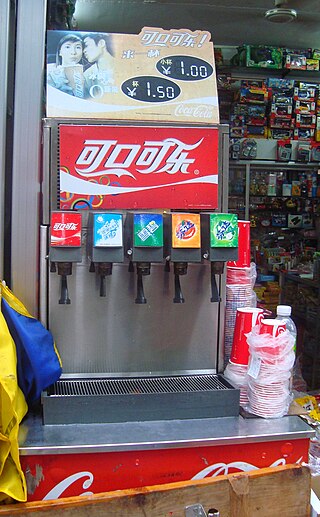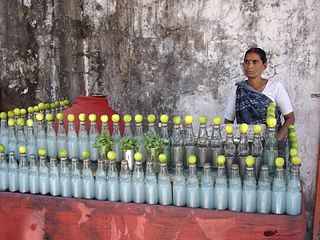
Carbon dioxide is a chemical compound with the chemical formula CO2. It is made up of molecules that each have one carbon atom covalently double bonded to two oxygen atoms. It is found in the gas state at room temperature, and as the source of available carbon in the carbon cycle, atmospheric CO2 is the primary carbon source for life on Earth. In the air, carbon dioxide is transparent to visible light but absorbs infrared radiation, acting as a greenhouse gas. Carbon dioxide is soluble in water and is found in groundwater, lakes, ice caps, and seawater. When carbon dioxide dissolves in water, it forms carbonate and mainly bicarbonate, which causes ocean acidification as atmospheric CO2 levels increase.

A soft drink is any water-based flavored drink, usually but not necessarily carbonated, and typically including added sweetener. Flavors used can be natural or artificial. The sweetener may be a sugar, high-fructose corn syrup, fruit juice, a sugar substitute, or some combination of these. Soft drinks may also contain caffeine, colorings, preservatives and other ingredients.

Ginger ale is a carbonated soft drink flavoured with ginger. It is consumed on its own or used as a mixer, often with spirit-based drinks. There are two main types of ginger ale. The golden style is credited to the Irish doctor Thomas Joseph Cantrell. The dry style, a paler drink with a much milder ginger flavour, was created by Canadian John McLaughlin.

Carbonated water is water containing dissolved carbon dioxide gas, either artificially injected under pressure or occurring due to natural geological processes. Carbonation causes small bubbles to form, giving the water an effervescent quality. Common forms include sparkling natural mineral water, club soda, and commercially produced sparkling water.

Bottled water is drinking water packaged in plastic or glass water bottles. Bottled water may be carbonated or not. Sizes range from small single serving bottles to large carboys for water coolers.

A water dispenser, known as water cooler, is a machine that dispenses and often also cools or heats up water with a refrigeration unit. It is commonly located near the restroom due to closer access to plumbing. A drain line is also provided from the water cooler into the sewer system.

Club soda is a form of carbonated water manufactured in North America, commonly used as a drink mixer. Sodium bicarbonate, potassium sulfate, potassium bicarbonate, potassium citrate, or sodium citrate is artificially added to replicate constituents commonly found in natural mineral waters and offset the acidity of introducing carbon dioxide gas.

A soda fountain is a device that dispenses carbonated soft drinks, called fountain drinks. They can be found in restaurants, concession stands and other locations such as convenience stores. The artifact combines flavored syrup or syrup concentrate and carbon dioxide with chilled and purified water to make soft drinks, either manually, or in a vending machine which is essentially an automated soda fountain that is operated using a soda gun. Today, the syrup often is pumped from a special container called a bag-in-box (BiB).

A keg is a small cask.

Beer head is the frothy foam on top of beer and carbonated beverages which is produced by bubbles of gas, predominantly carbon dioxide, rising to the surface. The elements that produce the head are wort protein, yeast and hop residue. The carbon dioxide that forms the bubbles in the head is produced during fermentation as yeasts break down sugar-rich molecules to produce ethanol and carbon dioxide. The carbonation can occur before or after bottling the beer. If the beer continues fermenting in the bottle, then it naturally carbonates and the head is formed upon opening and/or pouring the beer. If the beer is pasteurized or filtered then the beer must be force carbonated using pressurized gas.

Banta Soda, or Banta, also Goli Soda or Goti Soda and Fotash Jawl, is a popular carbonated lemon or orange-flavoured soft drink sold in India since the late 19th century in a distinctly shaped iconic Codd-neck bottle. The pressure created by the carbonated liquid seals the bottle by forcing a glass marble up into the neck of the bottle where it snugly locks into a rubber gasket. Opening the bottle by pressing on the marble thus releasing the pressurised gas is seen to be a fun experience. The drink is easily available at street-sellers, known as bantawallahs, at prices ranging from ₹5 (6.3¢ US) – ₹30 (38¢ US). The drink is sold in glass tumblers and plastic cups, and used to be served in kulhars.

A soda gun or bar gun is a device used by bars to serve various types of carbonated and non-carbonated drinks. A soda gun has the ability to serve any beverage that is some combination of syrup, water and carbon dioxide. This includes soft drinks, iced tea, carbonated water, and plain water. When served from a soda gun, these are often known as fountain drinks.

SodaStream International Ltd. is an Israel-based manufacturing company best known as the maker of the consumer home carbonation product of the same name. The company's soda machines, in the style of soda siphons, add carbon dioxide to water from a pressurized cylinder to create carbonated water for drinking. It also sells more than 100 types of concentrated syrups and flavourings that are used in the process of making carbonated drinks. In 2018, SodaStream distributed its products to 80,000 individual retail stores across 45 countries.

Dimethyl dicarbonate (DMDC) is a colorless liquid with a pungent odor at high concentration at room temperature. It is primarily used as a beverage preservative, processing aid, or sterilant being highly active against typical beverage spoiling microorganisms like yeast, bacteria, or mould.

A slushy is a type of beverage made of flavored ice and a drink, similar to granitas but with a more liquid composition. It is also commonly called a slush, slurpee, frozen beverage, or frozen drink. A slushie can either be carbonated or non-carbonated; the carbonated version is sometimes called a frozen carbonated drink or frozen carbonated beverage.
A soda geyser is a physical reaction between a carbonated beverage, usually Diet Coke, and Mentos mints that causes the beverage to be expelled from its container. The candies catalyze the release of gas from the beverage, which creates an eruption that pushes most of the liquid up and out of the bottle. Lee Marek and "Marek's Kid Scientists" were the first to publicly demonstrate the experiment on the Late Show with David Letterman in 1999. Steve Spangler's televised demonstration of the eruption in 2005 became popular on YouTube, launching a chain of several other Diet Coke and Mentos experiment viral videos. Experiments carried out at altitudes ranging from below sea level in Death Valley to the summit of Pikes Peak have demonstrated that the reaction works better at higher elevations.

A Cornelius keg is a stainless steel canister (keg) originally used as containers by the soft drink industry. They can be used to store and dispense carbonated or nitrogenated liquids. Cornelius kegs were originally made by Cornelius, Inc.

The soda siphon, also known as the seltzer bottle, siphon seltzer bottle, or just siphon) is a device for storing and dispensing carbonated beverages while maintaining the internal pressure, thereby preventing it from going flat. The carbonated beverage is dispensed using the internal pressure of the bottle, so the setup is not a true siphon in its operation.

Premix and postmix are two methods of serving soft drinks—usually carbonated—that are alternatives to bottles and cans.

Hard seltzer, adult seltzer, mature seltzer, spiked seltzer and hard sparkling alcohol water is a type of highball drink containing seltzer, alcohol, and often fruit flavorings. In the US the alcohol is usually made by fermenting cane sugar or malted barley. Hard seltzer products outside of the US have been found to use either neutral spirit, or fermentation of fruit. The alcohol by volume is around 5% and the calorie-content is relatively low.


















